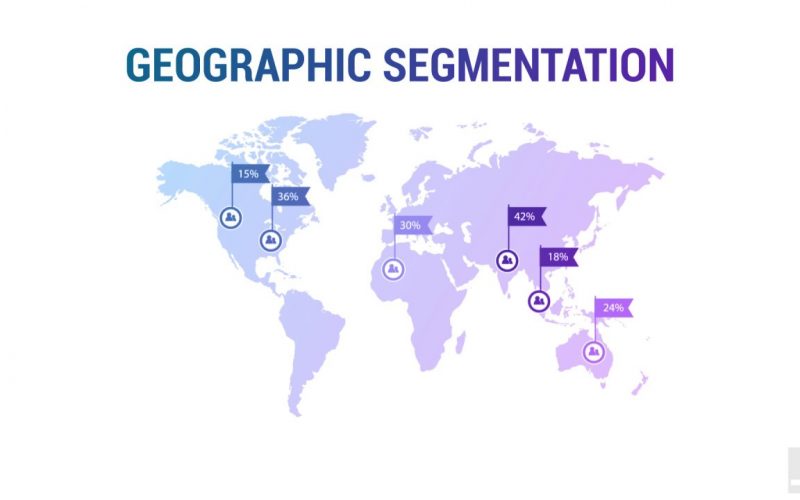Geographic segmentation is a sort of market segmentation. In which prospective customers are divided into groups according to where they live. Moreover, People that live in the same area have comparable desires and requirements. And geographic segmentation enables marketers to target customers in a country, city, or region. Plus a message that speaks to their particular wants and needs. So, this study explains the Examples, Variables, Advantages, and how marketers use Geographic segmentation.
Examples of Geographic segmentation
Examples : Location-based geographic segmentation
Though all geographic segmentation involves dividing clients. Just by their location in which they live or work. we’re currently talking about selling only based on a product’s availability in a specific area here. So, this is a handy tool for firms that only have the resources to service clients within a particular radius.
Subscription meal box service Oddbox had only had the infrastructure to deliver within London’s borders until recently. They have, nevertheless, recently extended to deliver to some other nearby city like Brighton.
They were able to target prospective consumers in the city. By using geographic segmentation and deliver relevant advertising via social media ads.
Segmentation by nation becomes really important for global brands. Like McDonald’s, it is one company that always tailors its adverts to the nation it is targeting.
Examples : Time zone geographic segmentation
Large firms benefit the most from timezone marketing because they are more likely to operate across numerous time zones. It may also be of relevance to smaller enterprises. Those that operate in countries with many time zones, such as the United States.
Furthermore, email marketing is one location that can greatly benefit from time zone segmentation. While important announcements should be delivered at a specific time. Generic email marketing typically benefits from being seen at a specific time of day.
Therefore, if you want your consumers to view your email first thing on Monday morning. Then segment by time zone allows it to arrive at 8:45 a.m. local time. And putting it right at the top of the pile.
Examples : Climate and season geographic segmentation
Nothing beats a poorly targeted advertisement. Except being caught without a winter jacket in the middle of a hard freeze. Marketing depends on the environment or season in a certain location. it enables you to present your client with the most relevant information.
Hence, Seasonal promotions, such as the IKEA deal tend to last for a long time. Just as they were pushed to British buyers just as summer began.
Additionally, they can also be particularly time-sensitive. Such as a supermarket’s ice cream offer during an unforeseen heatwave. However, you may get a little more imaginative if you’re targeting a location that is regularly hot.
Examples : Cultural preferences-based geographic segmentation
Different regions will have distinct elements that affect whether or not buyers purchase. In some circumstances, these values will be dictated. Just by the prevailing religious culture and practices. while in others, they may be more esoteric local behaviors that must be accommodated.
Religious dietary restrictions are a common factor for food makers. Companies that mainly produce gelatin-based sweets, such as Haribo. They use slightly modified formulas to appeal to the demands of specific groups.
Advantages of Geographic Segmentation
It Enables Huge Corporations to Target the Diverse wants and needs of Clients in Various Regions.
Geographic segmentation advantages is a powerful tool used by firms with vast worldwide markets. In order to better understand the location-based characteristics that make up a certain target market.
Consumers in different geographic regions often have varied requirements. With preferences, and cultural features that can be precisely addressed for more efficient and effective marketing.
Makes it Possible For Small Enterprises With Limited Resources To Be More Cost Effective.
Geographic segmentation advantages findings enable small firms to target their marketing efforts particularly on their designated area of interest, reducing unnecessary spending.
When geographic segmentation advantages are involve, data is use to inform creativity, the resultant content has a better probability for connecting and initiating a purchasing action. Therefore making marketing dollars go further than when a company just blasts each target category with the same message. The above are advantages of geographic segmentation.
Geographic Segmentation is Simple to Carry Out.
Geographic segmentation is a comparatively straightforward method of segmentation. when in comparison with other methods such as psychographic segmentation, demographic segmentation, or behavioral segmentation.
In simple terms, determining which geographic place someone lives in is a lot simpler than determining the variable components of their psychology or behavioral patterns. In addition, The geographical location of someone’s dwelling is an objective reality, however, the variable components of their personality and what motivates them to purchase are far more subjective.
Geographic Segmentation Variables
When undertaking market segmentation, avoid mixing two of the segmentation into a single one. Despite the fact that demographic and geographic segmentation is comparable, creating a combination of these variables is quite challenging.
Demographic Geographic Segmentation Variables
The demographic market segmentation is entirely on the client. Nevertheless, the characteristics that are assigned to the demographic market group differ depending on whether you run a B2B or B2C firm. If you run a B2B business, the features you would most likely include in this category include industry type, company size, time in position, and job within the organization.
A B2C company, on the other hand, might contain demographic characteristics such as age, education, gender, occupation, family status, and income.
This is a relatively typical sort of segmentation in use in market research to establish who a company’s primary target audience is. This information is also easily accessible.
Geographic Segmentation Variables
Geographic market segmentation enables you to fully segregate your whole target based on their location. which is essential when clients’ location influences their overall purchase decision. The region, continent, country, city, and district are some of the key attributes and segments that can be employed with geographic segmentation.
Meanwhile, this is a very common sort of segmentation that affects most clients in some way by where they live. Moreover, If a sizable portion of your target audience lives in the United Kingdom. Then you can utilize this information to build a co.uk website. This type of segmentation is seen to be appropriate for multinational corporations. Finally, Customers from various countries will have varying demands and needs, which can be accurately targeted in a marketing effort.
Psychographic Segmentation Variables
The goal of psychographic market segmentation is to divide the audience according to their personalities. This segmentation includes factors such as lifestyle, attitudes, hobbies, and values. However, because determining demographics in accordance with personality is relatively subjective, this type of segmentation will necessitate substantial research. If you, however, discover that your primary customer prioritizes quality and energy efficiency above all else, you may modify your advertising platform to reflect these key principles.
Behavioral Geographic Segmentation Variables
The behavioral market segmentation separates your entire audience according to historical behavior with your brand. Brand awareness, buying patterns, past purchases, awareness of your business, and product rating are some of the primary characteristics of this segmentation type.
How Do Marketers Use Geographic Segmentation?
A way marketers use geographic segmentation is by focusing on where their products are in need.
Another method marketers use geographic segmentation is If a sizable portion of your target audience lives in the United Kingdom, you can utilize this information to build a co.uk website. This type of segmentation is appropriate for multinational corporations. Moreover, Customers from various countries will have varying demands and needs, which can be accurately targeted in a marketing effort.
Many marketers believe this to be the most basic sort of market segmentation. It is also extremely advantageous for small firms with limited resources. If your primary geographic group responds better to web commercials than to TV and print ads, this information should help you allocate your resources more effectively.
Geographical Parameters for Segmentation
You can use a variety of geographical parameters, including:
#1. Location
Let’s get the obvious out of the way first. You have a lot of possibilities when you segment by place. It might be a city, a town, a country, or even an entire continent. Moreover, t his can also be utilized to locate a new geographic place into which your company may want to expand.
#2. Climate
Do you believe they are purchasing winter tires in Dubai? Climate segmentation assists you in identifying places where the climate is suitable for your product or service.
#3. Culture
When addressing your target market, you must consider cultural differences and sensitivities. White, for instance, represents purity, elegance, calm, and cleanliness in Western civilizations. White, on the other hand, is associated with death, mourning, and bad luck in China.
#4. Population
This might be based on population density or population type. For instance, a fitness chain would not open a gym in a rural location if it chose to focus on a densely populated metropolitan area. Furthermore, you may also use this tool to locate target audiences by overlaying demographic information.
#5. Urban, suburban, and rural areas
Because client needs vary across these three environments, each requires a unique marketing strategy. Because people in cities and suburbs have more purchasing power than those in rural areas, things can be more expensive.
#6. Language
Not every country wants or can be promoted in English. So, if you are doing a marketing effort, it is critical that it is done in the local language. Since all of your marketing messaging must be modified, you must ensure that you are ready to enter a market.
Why Do We Use Geographic Segmentation?
Geographic segmentation makes it possible for small enterprises with tight finances to operate more efficiently. Small firms may target their marketing efforts particularly at their designated area of interest thanks to the insights that come from geographic segmentation, which helps them save money.
What Are the Characteristics of Geographic Segmentation?
Geographic segmentation is a marketing approach that involves classifying clients into groups according to their geographic location. This tactic may involve segmenting customers according to their location, climate, population density, and other geographic factors that may be important to a firm.
Why Is Geographic Important in Marketing?
Geographical data may aid marketers globally in seeing the wider picture, fitting in with local cultures, and becoming more nimble and responsive in grabbing hold of fresh market opportunities to stay one step ahead of the competition.
What Is Your Geographic Market Area?
The geographical area for which a specific dealer is in charge of promoting, selling, leasing, or servicing equipment in accordance with a dealer agreement is referred to as the geographic market area.
What Is the Difference Between Demographic and Geographic?
The primary distinction between demographic and geographic segmentation is that the former group’s customers according to attributes like age, education, income level, and ethnicity, while the latter groups them according to their location.
Is Population Demographic or Geographic?
The statistical study of human populations is known as demography. Demography studies how populations change over time and space in terms of size, composition, and movement. It makes use of techniques from various disciplines, including anthropology, economics, and sociology.
What Is Geographic Segmentation Strategy?
A marketing technique that targets goods or services according to the locations of their users’ households is known as geographic segmentation. To comprehend the audience and promote a product or service appropriately, division is made according to nations, states, regions, cities, colleges, or areas.
Conclusion
The geographic segmentation is a marketing tactic that is used to target products or services to people who reside in or shop in a specific place.
Geographic segmentation FAQ’s
What is geographic segmentation strategy?
Geographic segmentation involves segmenting your audience based on the region they live or work in. This can be done in any number of ways: grouping customers by the country they live in, or smaller geographical divisions, from region to city, and right down to postal code.
What are the 5 main different segments for Geographic?
Marketers use various geographic segmentation variables that include the country, region, state, province, town, climate zone, or zip code. Culture and population density (urban or rural) are also crucial variables to include in their market research.
How do you create a geographic segmentation?
- Focus on One Area.
- Exploit Regional Preferences.
- Segment Markets for Seasonal Cycles.
- Target Geographic Characteristics.
- Types of Market Segmentation (+ Benefits, Tips & Examples)
- Market Segmentation: All you need to know with Examples
- CONSUMER MARKET: A Step by Step Guide (All you should know)
- Psychographic Segmentation: Advantages, tools (+ practical examples)
- MONEY NEUTRALITY: Understanding Money Neutrality with Ease
- Market Segments: Definition & List Of Different Market Segments






